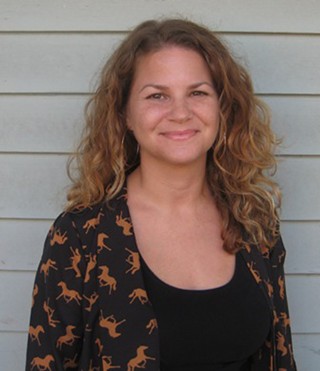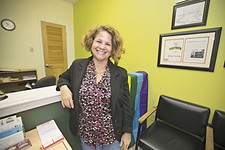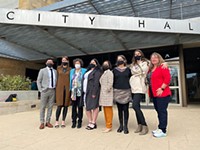Joining Forces Against HIV
Wright House reopens under one roof
By Sarah Marloff, Fri., April 10, 2015
On Friday, the Wright House Wellness Center will close its doors for five days. When they re-open on April 15, the nonprofit will at last be under one roof. For the past 18 years, the center, which serves Travis County residents living with HIV, has been operating out of two buildings miles apart from one another. "This move allows us to really come together as an organization," says WHWC Executive Director Leah Graham. "It'll also help our clients move more easily through the organization."
With a swell in local HIV-positive diagnoses and the threat of state budget cuts, the nonprofit's move couldn't come at a more crucial time. As of February 2014, Austin/Travis County Health and Human Services Department estimated that more than 5,000 Austin/Travis County residents were living with HIV. If that number sounds high, well, it is – in fact, it's gone up by 40% in the previous eight years. And, in 2013, 4,309 Texans tested newly positive, including 249 Travis County residents, according to the Texas Department of State Health Services. That gives Texas the third-highest HIV infection rate in the country.
"About 1,100 people in Travis County don't know they're positive," says Graham. "It's important that we identify those folks, get them into care, and get them on treatment." In 2012, the Centers for Disease Control and Prevention reworked its approach to fighting HIV. Now the CDC – and organizations receiving federal funding – primarily focuses on High-Impact Prevention, which targets high-risk populations, and linking newly diagnosed individuals to medical care. "Now there's a bigger push to get people tested," says Graham, "and that bridge between prevention and care has case managers working closer together, which means people are not falling through the cracks."
Despite the proven effectiveness of prevention strategies, the rising numbers are alarming. Both Graham and Paul E. Scott, the executive director of AIDS Services of Austin, believe complacency plays a large role in the shift. "Some people have decided HIV is curable or treatable so they don't feel like it's a consideration," says Scott. While testing positive is no longer a death sentence, and today's medications are far superior to the early AZT cocktails, HIV is still a serious health issue. "We're definitely seeing a change in people living with HIV, but we still have clients that are dying," Scott explains. "It all depends on when they test [positive], and are they able to stay in care? Are they able to get the support needed in order to take medication? At best, it's managing lifelong medication plus co-issues from HIV and meds."
Graham, who's been working with WHWC since 1999, agrees that while fewer people are dying, a broader spectrum of individuals is being infected, and numbers are rising for young gay and bisexual men, women – specifically African-American women – and youth. In 2013, Texas teens between the ages of 15 and 19 made up 10.7% of those infected (DSHS). "I have a 14-year-old daughter, and we talk about it quite a bit," Graham says. "I don't think it's ever too early to start educating."
Unfortunately, the Republican-controlled Texas House of Representatives doesn't see eye-to-eye with prevention workers. On March 31, the House approved an amendment to the state's budget that would cut $3 million from HIV funding and reallocate it for abstinence-only programs. Though the cuts are far from finalized, Graham and Scott are concerned. "We need to provide a menu of options to meet people where they're at – abstinence only doesn't do that," explains Graham. "If folks aren't getting prevention and safer sex education, it could lead to increased HIV positive cases, which would lead to increase of service, which means more funding will be needed."
Aside from the poor track record of abstinence-only programs, Scott adds: Waiting until marriage does not resonate with gay men, especially seeing as same-sex marriage is still illegal in Texas. "Prevention work has high success rate," says Scott. "And Austin has one of the highest retention rates for keeping people in care. Moving these well-proven dollars to a program that doesn't have good results is scary." The budget amendment is now on its way to the Senate. Once the Senate makes its recommendations, the differences between the two versions of the amendment will be sorted out before the 2015 legislative session ends on June 1.
As it's unclear if the cuts will come to fruition, local organizations plan to continue business as usual. ASA and WHWC are two of Austin's oldest HIV organizations, and frequently work together. WHWC, which began in 1988 (under its original name Austin Immune Health Clinic), serves a five-county area, and works primarily with African-American and Latino men who have sex with men, as well as African-American women.
ASA, on the other hand, works primarily with young gay men, men who sleep with men, and intravenous drug users. Both organizations have mobile testing vans that commute to community hubs including bars, apartment complexes, and rec centers – places where clients can easily access testing without being recognized. "Stigma plays a huge role in these communities," says Graham. "People are afraid to go to local clinics [to get tested] because they don't know who they might see."
However, stigma is exactly what organizations such as Out Youth are trying to eliminate. The 25-year-old nonprofit serves LGBTQ youth living in Central Texas. Most Mondays from 4:30 to 6:30 they run KYSS (Knowing Your Status is Smart), during which they offer testing and risk-reduction counseling for anyone between the ages of 14 and 23. "Most of our clients are getting tested for their first time," says Keisha Martinez, Out Youth's clinical services director. "Our goal is to promote healthy testing in a very positive space."
On April 25, these three organizations (and many more) will join forces to bike in the 16th Annual Hill Country Ride for AIDS, which benefits 10 local organizations. "It's one of my favorite events," says Graham. "It's always a community of love, but for a couple of days it's even more loving."
The Wright House will reopen at 9am Wednesday, April 15, at its new, combined location at 8101 Cameron Rd.
Got something to say on the subject? Send a letter to the editor.










